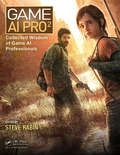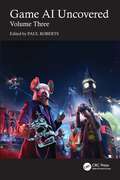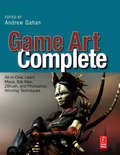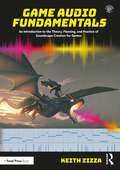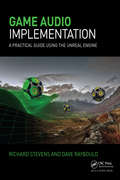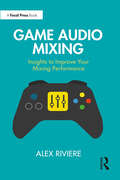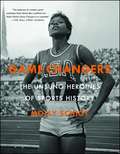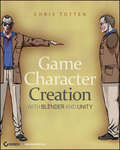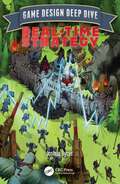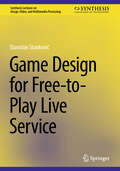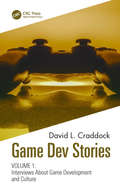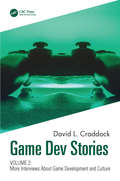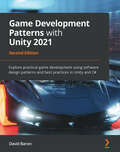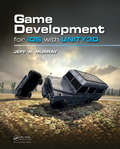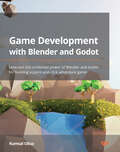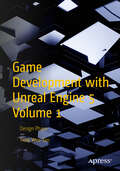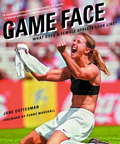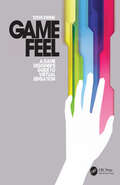- Table View
- List View
Game AI Pro 2: Collected Wisdom of Game AI Professionals
by Steven RabinGame AI Pro2: Collected Wisdom of Game AI Professionals presents cutting-edge tips, tricks, and techniques for artificial intelligence (AI) in games, drawn from developers of shipped commercial games as well as some of the best-known academics in the field. It contains knowledge, advice, hard-earned wisdom, and insights gathered from across the com
Game AI Uncovered: Volume Three
by Paul Roberts Nicholas DentGame AI Uncovered: Volume Three continues the series with another collection of chapters from 18 of the top game AI professionals and researchers, from around the world. Each chapter includes wisdom, ideas, tips, and tricks that were used in the development of video games.The techniques discussed in these pages cover the underlying development of a wide array of published titles, including Watch Dogs: Legion, City of Gangsters, Eve: Valkyrie, Firefall, The Persistence, Advance Soccer, Alpha Beta Gunner, and Luna Abyss.Contained within this volume are insights that cover a host of different areas within game AI, including vehicle AI, simulating social norms, AI spawning fundamentals, pathfinding, creation of characters using components, animation‑driven behaviour, tactical positioning in football, automated testing, abstract pattern matching, and machine learning for games.Beginners in the area of game AI, along with professional developers, will find a wealth of knowledge that will not only help in the development of their own games but also spark ideas for new approaches.This volume includes chapters written by Dr Allan Bruce, Anubha Banerjee, Bruno Rebaque, Dale Green, David Wooldridge, Eric S. Le Saux, Greg Irwin, Jason Lok Heng Chin, Johan Holthausen, John Reynolds, Mathias Siemonsmeier, Michele Condò, Dr Nic Melder, Paul Roberts, Phil Carlisle, Richard Bull, Robert Zubek, and Tobias Karlsson.
Game Art Complete: All-in-One: Learn Maya, 3ds Max, ZBrush, and Photoshop Winning Techniques
by Andrew GahanA compilation of key chapters from the top Focal game art books available today - in the areas of Max, Maya, Photoshop, and ZBrush. The chapters provide the CG Artist with an excellent sampling of essential techniques that every 3D artist needs to create stunning game art.Game artists will be able to master the modeling, rendering, rigging, and texturing techniques they need - with advice from Focal's best and brightest authors. Artists can learn hundreds of tips, tricks and shortcuts in Max, Maya, Photoshop, ZBrush - all within the covers of one complete, inspiring reference.
Game Art: Art from 40 Video Games and Interviews with Their Creators
by Matt SainsburyGame Art is a collection of breathtaking concept art and behind-the-scenes interviews from videogame developers, including major players like Square Enix, Bioware, and Ubisoft as well as independent but influential studios like Tale of Tales and Compulsion Games. Immerse yourself in fantastic artwork and explore the creative thinking behind over 40 console, mobile, and PC games.A lone independent developer on a tiny budget can create an experience as powerful and compelling as a triple-A blockbuster built by a team of 1,000. But like all works of art, every game begins with a spark of inspiration and a passion to create.Let Game Art take you on a visual journey through these beautiful worlds, as told by the minds that brought them to life.
Game Audio Fundamentals: An Introduction to the Theory, Planning, and Practice of Soundscape Creation for Games
by Keith ZizzaGame Audio Fundamentals takes the reader on a journey through game audio design: from analog and digital audio basics to the art and execution of sound effects, soundtracks, and voice production, as well as learning how to make sense of a truly effective soundscape. Presuming no pre-existing knowledge, this accessible guide is accompanied by online resources – including practical examples and incremental DAW exercises – and presents the theory and practice of game audio in detail, and in a format anyone can understand. This is essential reading for any aspiring game audio designer, as well as students and professionals from a range of backgrounds, including music, audio engineering, and game design.
Game Audio Implementation: A Practical Guide Using the Unreal Engine
by Richard Stevens Dave RaybouldGame Audio Implementation offers a unique practical approach to learning all about game audio. If you've always wanted to hear your sound or music in a real game then this is the book for you. Each chapter is accompanied by its own game level where you can see the techniques and theories in action before working through over 70 exercises to develop your own demo level. Taking you all the way from first principles to complex interactive systems in the industry standard Unreal Engine© you’ll gain the skills to implement your sound and music along with a deep transferable knowledge of the principles you can apply across a range of other game development tools. <P><P> The accompanying website (www.gameaudioimplementation.com) includes: <P><P> <P><P>12 downloadable demonstration games <P><P>A unique exercise level for you to develop for your portfolio <P><P>An up-to-date online bibliography with further reading for each chapter <P><P>A free sound library with hundreds of game SFX
Game Audio Mixing: Insights to Improve Your Mixing Performance
by Alex RiviereGame Audio Mixing offers a holistic view of the mixing process for games, from philosophical and psychological considerations to the artistic considerations and technical processes behind acoustic rendering, interactive mixing, mastering, and much more. This book includes a comprehensive overview of many game audio mixing techniques, processes, and workflows, with advice from audio directors and sound supervisors. Through a series of accessible insights and interviews, the reader is guided through cutting-edge tips and tricks to equip them to improve their own mixing practice. As well as covering how to plan and create a mix that is clear, focused, and highly interactive, this book provides information about typical mixing tools and techniques, such as dealing with bus structure, frequency spectrum, effects, dynamic, volume, 2D and 3D spaces, and automations. Key information about how to deal with a large number of sounds and their prioritization in the mix is also included, from high-level mixing visions to in-depth designs with sound categorizations at the core. Game Audio Mixing is essential reading for all game audio professionals, including those new to the industry, as well as experienced professionals working on AAA and indie titles, in addition to aspiring professionals and hobbyists.
Game Changers: The Unsung Heroines of Sports History
by Molly Schiot&“The embrace of women&’s sports sometimes feels almost like a political act...Molly Schiot&’s Game Changers: The Unsung Heroines of Sports History is so valuable.&” —The Wall Street Journal &“A thoughtful, exhaustively researched, and long-overdue tribute to the women who have paved the way for the likes of Serena Williams, Abby Wambach, Simone Biles, and more.&” —espnW Based on the Instagram account @TheUnsungHeroines, a celebration of the pioneering, forgotten female athletes of the twentieth century that features rarely seen photos and new interviews with past and present game changers including Abby Wambach and Cari Champion.Two years ago, filmmaker Molly Schiot began the Instagram account @TheUnsungHeroines, posting a photo each day of a female athlete who had changed the face of sports around the globe in the pre-Title IX age. These women paved the way for Serena Williams, Carli Lloyd, and Lindsey Vonn, yet few today know who they are. Slowly but surely, the account gained a following, and the result is Game Changers, a beautifully illustrated collection of these trailblazers’ rarely-before-seen photos and stories. Featuring icons Althea Gibson and Wyomia Tyus, complete unknowns Trudy Beck and Conchita Cintron, policymaker Margaret Dunkle, sportswriter Lisa Olson, and many more, Game Changers gives these “founding mothers” the attention and recognition they deserve, and features critical conversations between past and present gamechangers—including former US Women’s National Soccer Team captain Abby Wambach and SportsCenter anchor Cari Champion—about what it means to be a woman on and off the field. Inspiring, empowering, and unforgettable, Game Changers is the perfect gift for anyone who has a love of the game.
Game Character Creation with Blender and Unity
by Chris TottenA complete guide to creating usable, realistic game characters with two powerful toolsCreating viable game characters requires a combination of skills. This book teaches game creators how to create usable, realistic game assets using the power of an open-source 3D application and a free game engine. It presents a step-by-step approach to modeling, texturing, and animating a character using the popular Blender software, with emphasis on low polygon modeling and an eye for using sculpting and textures, and demonstrates how to bring the character into the Unity game engine. Game creation is a popular and productive pursuit for both hobbyists and serious developers; this guide brings together two effective tools to simplify and enhance the processArtists who are familiar with Blender or other 3D software but who lack experience with game development workflow will find this book fills important gaps in their knowledgeProvides a complete tutorial on developing a game character, including modeling, UV unwrapping, sculpting, baking displacements, texturing, rigging, animation, and exportEmphasizes low polygon modeling for game engines and shows how to bring the finished character into the Unity game engineWhether you're interested in a new hobby or eager to enter the field of professional game development, this book offers valuable guidance to increase your skills.
Game Design Deep Dive: Real-Time Strategy (Game Design Deep Dive)
by Joshua BycerGame Design Deep Dive: Real‑Time Strategy focuses on what was once one of the most popular genres in the world and the one that truly kicked off the rise of eSports. It has seen more fundamental changes as a genre than any other genre, and Game Design Critic Josh Bycer will talk about its history and where it stands today with regard to its relevancy in the market.Key Features: Discusses balancing and designing asymmetrical features and units. Explores user interface (UI)/user experience (UX) design and building effective GUIs. Examines the differences between multiplayer and single‑player balancing and how to appeal to both audiences. Provides predictions on the next big trend for the genre.
Game Design Deep Dive: Role Playing Games
by Joshua BycerGame Design Critic Josh Bycer is back with another entry in the Game Design Deep Dive series to discuss the Role-Playing Game genre. Arguably one of the most recognizable in the industry today, what is and what isn’t an RPG has changed over the years. From the origins in the tabletop market, to now having its design featured all over, it is one of the most popular genres to draw inspiration from and build games around. This is a genre that looks easy from the outside to make, but requires understanding a variety of topics to do right. • A breakdown of RPG mechanics and systems, perfect for anyone wanting to study or make one themselves • The history of the genre – from tabletop beginnings to its worldwide appeal • The reach of the genre – a look at just some of the many different takes on RPGs that have grown over the past 40 years • An examination of how RPG systems can be combined with other designs to create brand new takes
Game Design Essentials
by Briar Lee MitchellAn easy-to-follow primer on the fundamentals of digital game designThe quickly evolving mobile market is spurring digital game creation into the stratosphere, with revenue from games exceeding that of the film industry. With this guide to the basics, you'll get in on the game of digital game design while you learn the skills required for storyboarding, character creation, environment creation, level design, programming, and testing.Teaches basic skill sets in the context of current systems, genres, and game-play stylesDemonstrates how to design for different sectors within gaming including console, PC, handheld, and mobileExplores low-poly modeling for game playAddresses character and prop animation, lighting and rendering, and environment designDiscusses the path from concept to product, including pre- and post-productionIncludes real-world scenarios and interviews with key studio and industry professionalsWith Game Design Essentials, you'll benefit from a general-but-thorough overview of the core art and technology fundamentals of digital game design for the 21st century.
Game Design for Free-to-Play Live Service (Synthesis Lectures on Image, Video, and Multimedia Processing)
by Stanislav Stanković"Game Design for Free to Play Live Service" is the ultimate guide to designing successful free-to-play mobile games. Based on a decade of experience at companies like Rovio, EA, and Supercell, the author provides practical advice on gameplay mechanics, monetization strategies, and player engagement. With case studies and expert insights, this book is essential reading for any game developer looking to create a hit mobile game.
Game Dev Stories Volume 1: Interviews About Game Development and Culture
by David L. CraddockGame Dev Stories: Interviews About Game Development and Culture Volumes 1 and 2 are a collection of interviews from renowned author David L. Craddock as he explores all corners of the video game industry. Collected from the author's archives, Game Dev Stories gathers conversations with individuals from all corners of the industry: Who they are, the paths they paved, and their contributions to this multibillion-dollar industry. This text offers viewpoints from well-known individuals like John Romero, Tom Hall, and Matt Householder. From artists and writers to programmers and designers, Game Dev Stories offers amazing insights and understanding to what occurs behind the screens of your favorite games and may help inspire future game developers in pursuing their dreams. Author Bio David L. Craddock writes fiction, nonfiction, and grocery lists. He is the author of over a dozen nonfiction books about video game development and culture, including the bestselling Stay Awhile and Listen series, Arcade Perfect: How Pac-Man, Mortal Kombat, and Other Coin-Op Classics Invaded the Living Room, and fiction for young adults, including The Dumpster Club and Heritage: Book One of the Gairden Chronicles. Find him online @davidlcraddock on Twitter.
Game Dev Stories Volume 2: More Interviews About Game Development and Culture
by David L. CraddockGame Dev Stories: Interviews About Game Development and Culture Volumes 1 and 2 are a collection of interviews from renowned author David L. Craddock as he explores all corners of the video game industry. Collected from the author's archives, Game Dev Stories gathers conversations with individuals from all corners of the industry: Who they are, the paths they paved, and their contributions to this multibillion-dollar industry. This text offers viewpoints from well-known individuals like John Romero, Tom Hall, and Matt Householder. From artists and writers to programmers and designers, Game Dev Stories offers amazing insights and understanding to what occurs behind the screens of your favorite games and may help inspire future game developers in pursuing their dreams. Author Bio David L. Craddock writes fiction, nonfiction, and grocery lists. He is the author of over a dozen nonfiction books about video game development and culture, including the bestselling Stay Awhile and Listen series, Arcade Perfect: How Pac-Man, Mortal Kombat, and Other Coin-Op Classics Invaded the Living Room, and fiction for young adults, including The Dumpster Club and Heritage: Book One of the Gairden Chronicles. Find him online @davidlcraddock on Twitter.
Game Development Patterns with Unity 2021: Explore practical game development using software design patterns and best practices in Unity and C#
by David BaronSolve your programming woes in Unity with practical design propositionsKey FeaturesGain a comprehensive overview of Unity engine architecture and coding modelBuild a complete racing game using software design patterns and understand how to implement them in UnityDownload the source code of the complete prototype demonstrating each of the software patterns usedBook DescriptionThis book is written for every game developer ready to tackle the bigger picture and start working with advanced programming techniques and design patterns in Unity. Game Development Patterns with Unity 2021 is an introduction to the core principles of reusable software patterns and how to employ them to build components efficiently. In this second edition, you'll tackle design patterns with the help of a practical example; a playable racing game prototype where you’ll get to apply all your newfound knowledge. Notable updates also include a game design document (GDD), a Unity programming primer, and the downloadable source code of a complete prototype. Your journey will start by learning about overall design of the core game mechanics and systems. You’ll discover tried-and-tested software patterns to code essential components of a game in a structured manner, and start using classic design patterns to utilize Unity's unique API features. As you progress, you'll also identify the negative impacts of bad architectural decisions and understand how to overcome them with simple but effective practices. By the end of this Unity book, the way you develop Unity games will change – you’ll adapt a more structured, scalable, and optimized process that will help you take the next step in your career. What you will learnStructure professional Unity code using industry-standard development patternsIdentify the right patterns for implementing specific game mechanics or featuresDevelop configurable core game mechanics and ingredients that can be modified without writing a single line of codeReview practical object-oriented programming (OOP) techniques and learn how they re used in the context of a Unity projectBuild unique game development systems such as a level editorExplore ways to adapt traditional design patterns for use with the Unity APIWho this book is forThis book is for Unity game developers who want to learn industry standards for building Unity games. Knowledge of the Unity game engine and programming in the C# language is a must, so if you’re a beginner, try our Learning C# by Developing Games with Unity 2021 handbook instead.
Game Development Patterns with Unity 2021: Explore practical game development using software design patterns and best practices in Unity and C#, 2nd Edition
by David BaronDiscover practical design propositions to resolve game programming challenges in UnityKey FeaturesGet an overview of Unity engine architecture and coding modelBuild a complete racing game using software design patterns and understand how to implement them in UnityDownload the source code of the complete prototype demonstrating each of the software patterns usedBook DescriptionUnity's coding model and architecture require knowledge of common software design patterns. To optimally code a game in Unity, in the same way you do in other engines, you'll have to adapt to programming techniques that involve the use of design patterns. In this second edition, you'll get to grips with using design patterns with the help of supplemented code examples based on actual implementations of game mechanics and systems of a playable racing game prototype. You'll be introduced to the core principles of reusable software patterns and how to employ them to build components efficiently. Some notable additions include a game design document (GDD), a Unity programming primer, and the downloadable source code of a complete prototype. You'll start by learning about the overall design of the core game mechanics and systems that you'll be building throughout this Unity book, and discover tried-and-tested software patterns to code essential components of a game in a structured manner. You'll also find out how you can use classic design patterns to utilize Unity's unique API features. Finally, you'll identify the negative impacts of bad architectural decisions and understand how to overcome them with simple but effective practices. By the end of this book, you'll be able to develop Unity games in a structured, scalable, and optimized way.What you will learnStructure professional Unity code using industry-standard development patternsIdentify the right patterns for implementing specific game mechanics or featuresDevelop configurable core game mechanics and ingredients that can be modified without writing a single line of codeReview practical object-oriented programming (OOP) techniques and learn how they're used in the context of a Unity projectBuild unique game development systems such as a level editorExplore ways to adapt traditional design patterns for use with the Unity APIWho this book is forThis book is for Unity game developers who want to learn industry standards for building Unity games. Knowledge of the Unity game engine and programming in the C# language is expected. If you're only just starting your journey to becoming a Unity game developer, this book is not suitable for you.
Game Development for iOS with Unity3D
by Jeff W. MurrayThis hands-on guide takes you through the complete process of Unity iOS game development. A game developer for over 12 years, the author presents production-proven techniques and valuable tips and tricks needed to plan, build, test, and launch games for the iPhone, iPod, and iPad. He walks you through all the necessary procedures, including how to publish your game to the App Store.
Game Development with Blender and Godot: Leverage the combined power of Blender and Godot for building a point-and-click adventure game
by Kumsal ObuzUnderstand how to use one of the most popular 3D modeling software and advanced game engines to create a seamless workflow between the two and produce dynamic gamesKey FeaturesLearn how to create, rig, and animate 3D low-poly models in BlenderDiscover the 3D workflow of Godot Engine and understand how to enhance your modelsUse modeling and game design skills to create a dynamic point-and-click gameBook DescriptionGame Development with Blender and Godot is a comprehensive introduction for those new to building 3D models and games, allowing you to leverage the abilities of these two technologies to create dynamic, interactive, and engaging games.This book will start by focusing on what low-poly modeling is, before showing you how to use Blender to create, rig, and animate your models. You will also polish these assets until they're game-ready, making it easy for you to import them into Godot and use them effectively and efficiently. Next, you will use the game engine to design scenes, work with light and shadows, and transform your 3D models into interactive, controllable assets.By the end of this book, you will have a seamless workflow between Blender and Godot which is specifically geared toward game development. Alongside, you'll also be building a point-and-click adventure game following the instructions and guidance in the book. Finishing this game will help you take these newly acquired skills and create your own 3D games from conception to completion.What you will learnDiscover what low-poly modeling is and why it mattersUnderstand how to use materials, shaders, and textures in your modelsExplore how to render and animate a scene in BlenderFocus on how to export Blender assets and import them into GodotUse 3D low-poly models in Godot to create fun gamesDesign a dynamic and easy-to-navigate game worldExplore how to interact with the game via interfacesUnderstand how to export your game for WindowsWho this book is forThis book is for game developers who are looking to make the transition from 2D to 3D games. Readers should have a basic understanding of Godot, being able to navigate the UI, understand the inspector panel, create scenes, add scripts to game objects, and more. Previous experience with Blender is helpful but not required.
Game Development with Unreal Engine 5 Volume 1: Design Phase
by Tiow Wee TanDive into the heart of game development with Unreal Engine 5 (UE5), the latest revolution in creating immersive and visually stunning game worlds. Crafted to encourage your imaginative and inventive skills, Volume 1 of this two-part guide stands as a crucial tool in your journey towards developing incredible video games with UE5 and serves as a transition into the programming dimensions of game creation with C++ featured in Volume 2. Blending artistic mastery with technical prowess, you’ll journey from the basics of UE5’s environment to creating expansive landscapes with procedural content generation and combining materials for lifelike terrains. Discover the power of Quixel Bridge and Megascans to bring realistic textures and models into your projects, and master Nanite for rendering complex scenes with cinematic fidelity. You’ll also learn to create dynamic lighting and shadow effects with Lumen, enrich your game’s atmosphere with sophisticated particle systems using Niagara. Then integrate characters and adversaries into our worlds, making them come alive with interactive elements. From designing large open landscapes to implementing advanced visual effects, Game Development with UE 5, Volume 1 is your gateway to elevating the visual appeal and interactive experience of your game. What You Will Learn Sculpt vast, open worlds with UE5's advanced landscape tools and Heightmaps. Construct highly detailed environments with Nanite, achieving unparalleled visual quality without sacrificing performance. Introduce dynamic global illumination with Lumen, crafting stunning lighting and shadow effects that respond to changes in the game world in real-time. Implement Real-Time Virtual Textures to significantly enhance texture streaming efficiency in large-scale environments. Use Procedural Content Graph to populate your game worlds with dynamic, lifelike vegetation that adds depth and realism to your landscapes. Explore Niagara's powerful visual effects system to create complex and captivating effects that elevate the aesthetic appeal of your game. Who This Book Is For Game developers who want to learn how to use Unreal Engine 5 would benefit from this book.
Game Engine Architecture
by Jason GregoryHailed as a "must-have textbook" (CHOICE, January 2010), the first edition of Game Engine Architecture provided readers with a complete guide to the theory and practice of game engine software development. Updating the content to match today’s landscape of game engine architecture, this second edition continues to thoroughly cover the major components that make up a typical commercial game engine. New to the Second Edition Information on new topics, including the latest variant of the C++ programming language, C++11, and the architecture of the eighth generation of gaming consoles, the Xbox One and PlayStation 4 New chapter on audio technology covering the fundamentals of the physics, mathematics, and technology that go into creating an AAA game audio engine Updated sections on multicore programming, pipelined CPU architecture and optimization, localization, pseudovectors and Grassman algebra, dual quaternions, SIMD vector math, memory alignment, and anti-aliasing Insight into the making of Naughty Dog’s latest hit, The Last of Us The book presents the theory underlying various subsystems that comprise a commercial game engine as well as the data structures, algorithms, and software interfaces that are typically used to implement them. It primarily focuses on the engine itself, including a host of low-level foundation systems, the rendering engine, the collision system, the physics simulation, character animation, and audio. An in-depth discussion on the "gameplay foundation layer" delves into the game’s object model, world editor, event system, and scripting system. The text also touches on some aspects of gameplay programming, including player mechanics, cameras, and AI. An awareness-building tool and a jumping-off point for further learning, Game Engine Architecture, Second Edition gives readers a solid understanding of both the theory and common practices employed within each of the engineering disciplines covered. The book will help readers on their journey through this fascinating and multifaceted field.
Game Engine Architecture
by Jason GregoryIn this new and improved third edition of the highly popular Game Engine Architecture, Jason Gregory draws on his nearly two decades of experience at Midway, Electronic Arts and Naughty Dog to present both the theory and practice of game engine software development. In this book, the broad range of technologies and techniques used by AAA game studios are each explained in detail, and their roles within a real industrial-strength game engine are illustrated.New to the Third Edition This third edition offers the same comprehensive coverage of game engine architecture provided by previous editions, along with updated coverage of: computer and CPU hardware and memory caches compiler optimizations C++ language standardization the IEEE-754 floating-point representation 2D user interfaces plus an entirely new chapter on hardware parallelism and concurrent programming This book is intended to serve as an introductory text, but it also offers the experienced game programmer a useful perspective on aspects of game development technology with which they may not have deep experience. As always, copious references and citations are provided in this edition, making it an excellent jumping off point for those who wish to dig deeper into any particular aspect of the game development process.Key Features Covers both the theory and practice of game engine software development Examples are grounded in specific technologies, but discussion extends beyond any particular engine or API. Includes all mathematical background needed. Comprehensive text for beginners and also has content for senior engineers.
Game Engine Gems 2
by Eric LengyelThis book, the second volume in the popular Game Engine Gems series, contains short articles that focus on a particular technique, describe a clever trick, or offer practical advice within the subject of game engine development. The 31 chapters cover three broad categories-graphics and rendering, game engine design, and systems programming. Profess
Game Face: What Does a Female Athlete Look Like?
by Jane GottesmanThe extraordinary collection of photographs and rich personal stories that make upGame Facedocuments the tremendous impact that sports has on the daily lives of millions of girls and women. On playing fields and street corners, in backyards and gyms, the people in this arresting array of pictures are unselfconsciously exploring the physical and emotional pleasures of competition and play. Each image offers an affirming and satisfying answer to the question at the heart ofGame Face: What do girls and women look like, freed from traditional feminine constraints, using their bodies in joyful and empowering ways? When Title IX was passed in 1972, only one out of twenty-seven school-age girls played sports. Now one in three does. Yet their expanding involvement in sports is still largely overlooked by the media, and as a consequence, millions of young female athletes crave not only role models but an authentic and appealing reflection of their own athleticism. As a young sports journalist, Jane Gottesman was all too aware of this imbalance, and saw the need for a book that honors both our top female athletes and the everyday girls and women whose self-image is strengthened through athletic participation. With the goal of showing America what women's sports looks like, she searched through the work of our country's best photographers, from the newest photojournalists to artists such as Annie Leibovitz and Ansel Adams. The result isGame Face, a unique and inspiring selection of color and black-and-white photographs, a text with first-person accounts by athletes, and an illustrated time line of women's athletic milestones. Published simultaneously with the opening of an important exhibition at the Smithsonian Institution that will tour for five years,Game Facehas been endorsed by the Girl Scouts of the USA, who've developed aGame Facepatch, the NCAA, and the YWCA of the USA. An inspiring gift for an athlete of any age, this powerful, timely book takes one of art's most studied subjects the female body and celebrates it in a brand-new way.
Game Feel: A Game Designer's Guide to Virtual Sensation
by Steve Swink"Game Feel" exposes "feel" as a hidden language in game design that no one has fully articulated yet. The language could be compared to the building blocks of music (time signatures, chord progressions, verse) - no matter the instruments, style or time period - these building blocks come into play. Feel and sensation are similar building blocks whe
